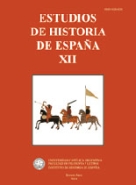Por favor, use este identificador para citar o enlazar este ítem:
https://repositorio.uca.edu.ar/handle/123456789/6666| Título: | “Quislibet sanctus mortuum potest suscitare” : peregrinos y muerte en la hagiografía castellana (siglos VII-XIII) | Autor: | Guiance, Ariel | Palabras clave: | EDAD MEDIA; HAGIOGRAFIA; SANTIDAD; PEREGRINACIONES | Fecha de publicación: | 2010 | Editorial: | Pontificia Universidad Católica Argentina. Facultad de Filosofía y Letras. Departamento de Historia. Instituto de Historia de España | Cita: | Guiance, A. “Quislibet sanctus mortuum potest suscitare” : peregrinos y muerte en la hagiografía castellana (siglos VII-XIII) [en línea]. Estudios de Historia de España. 2010, 12(2) Disponible en: https://repositorio.uca.edu.ar/handle/123456789/6666 | Resumen: | Resumen: Entre las muchas variables que rodean el fenómeno de la santidad medieval, siempre ocupó un lugar destacado el tema del desplazamiento de devotos y fieles a los centros que conservaban las reliquias de dichos santos. Agrupados tradicionalmente con el rótulo de “peregrinaciones”, esos traslados surgieron con el inicio mismo del culto cristiano, dando lugar a una de las principales manifestaciones de la piedad. En ese marco de viajes particulares, varios son los relatos hagiográficos que hacen explícita referencia a un fenómeno particular. Se trata de la peregrinación que llevan a cabo numerosos creyentes a ciertos santuarios, peregrinación que es interrumpida por la muerte del visitante. En otros casos, se narran viajes que se realizan para implorar la ayuda divina ante un posible suicidio o que buscan la resurrección de un familiar inesperadamente fallecido en el camino. Tales relatos son los que me ocuparán en esta oportunidad, intentando brindar un esquema compositivo de los textos en cuestión, a la vez que poniendo de relieve las coordenadas discursivas de esas historias maravillosas. Para ello, apelaré a algunas de las vidas de santos compuestas en la Península Ibérica entre los siglos VII y XIII, que incluyen pasajes relativos a los problemas señalados. Abstract: Among many variables that surround the phenomenon of the medieval holiness, the topic of the displacement of devout and faithful to the centers were relics of saints were kept was always placed as a key topic. Grouped traditionally with the title of “peregrinations”, these movements arose with the beginning itself of the Christian worship, giving place to one of the principal manifestations of the piety. In this frame of particular trips, several are the hagiographical statements that do explicit reference to a particular phenomenon. It is a question of the peregrination that numerous believers carry out to certain sanctuaries, peregrination that is interrupted by the death of the visitor. In other cases, there are narrated trips that are done to implore the divine help before a possible suicide or that seek for the resurrection of an unexpectedly deceased relative in the way. Such statements are those that will occupy me in this opportunity, trying to offer a scheme of the texts in question, emphasizing the discursive lines of these wonderful histories. For it, I will work with some of the saints’ lives composed in the Iberian Peninsula between the VIIth and XIIIth centuries, which include passages relative to this problems. |
Cobertura Espacial: | ESPAÑA | URI: | https://repositorio.uca.edu.ar/handle/123456789/6666 | ISSN: | 0328-0284 2469-0961 (online) |
Disciplina: | HISTORIA | Derechos: | Acceso Abierto | Fuente: | Estudios de Historia de España. 2010, 12(2) |
| Aparece en las colecciones: | EHE - 2010 vol. 12 Tomo II |
Ficheros en este ítem:
| Fichero | Descripción | Tamaño | Formato | |
|---|---|---|---|---|
| quislibet-sanctus-mortuum-potest-suscitare.pdf | 296,69 kB | Adobe PDF |  Visualizar/Abrir |
Visualizaciones de página(s)
108
comprobado en 30-abr-2024
Descarga(s)
49
comprobado en 30-abr-2024
Google ScholarTM
Ver en Google Scholar
Este ítem está sujeto a una Licencia Creative Commons

